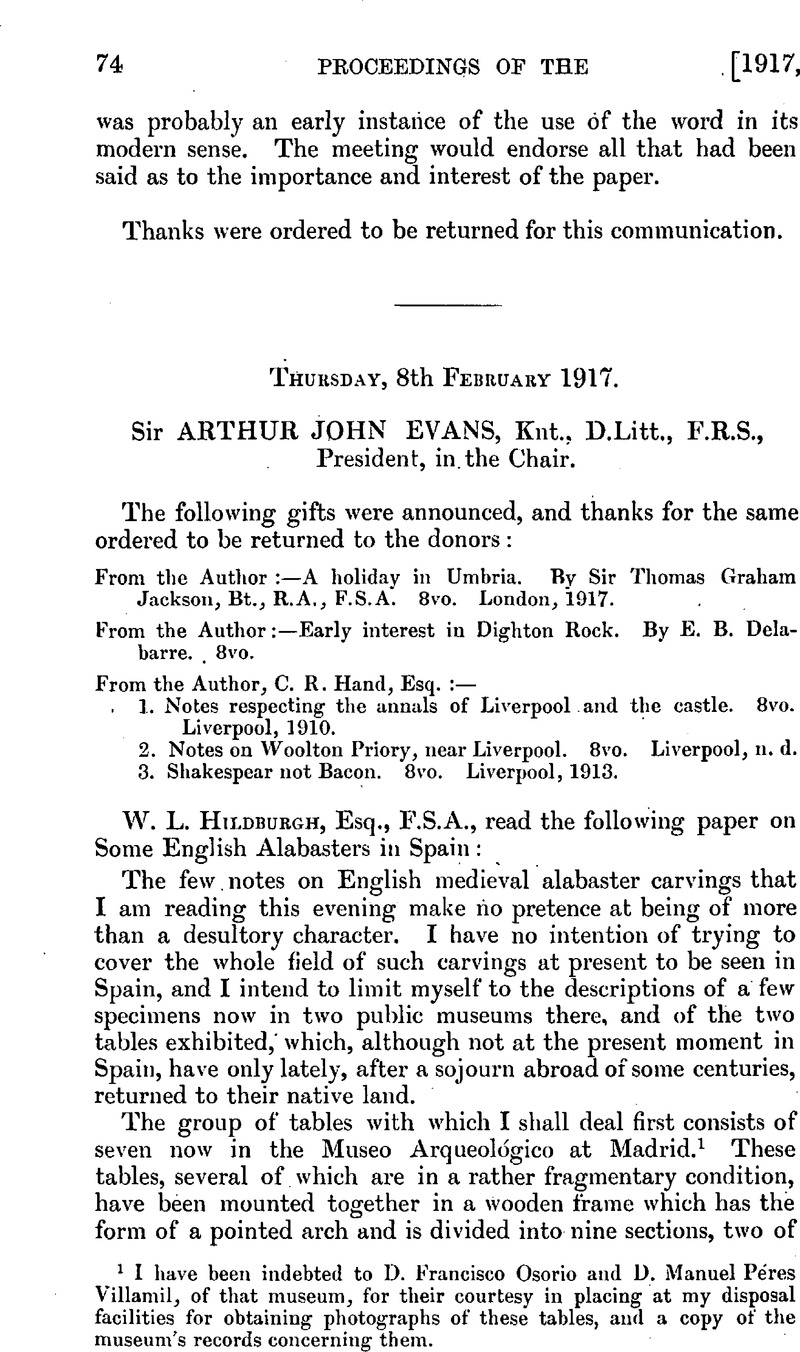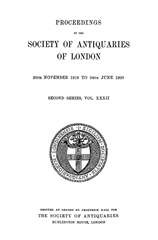No CrossRef data available.
Article contents
Thursday, 8th February 1917
Published online by Cambridge University Press: 10 May 2010
Abstract

- Type
- Proceedings
- Information
- Copyright
- Copyright © The Society of Antiquaries of London 1917
References
page 74 note 1 I have been indebted to D. Francisco Osorio and D. Manuel Peres Villamil, of that museum, for their courtesy in placing at my disposal facilities for obtaining photographs of these tables, and a copy of the museum's records concerning them.
page 78 note 1 ‘Gospel of Pseudo-Matthew,’ chap, iv, as given in Cowper's, B. Harris The Apocryphal Gospels, London, 1897.Google Scholar
page 78 note 2 ‘Gospel of the Nativity of Mary,’ chap. vi.
page 78 note 3 See Sir William Hope's remarks, infra.
page 78 note 4 ‘Pseudo-Matthew’ (loc. cit.) does not mention the altar, but says merely that ‘When.she had been set before the gates of the temple she went up the fifteen steps …’.
page 79 note 1 Jameson, A., Legends of the Madonna, 3rd ed., London, 1864, p. 151.Google Scholar
page 80 note 1 ‘Nativity of Mary,’ vii.
page 80 note 2 ‘Pseudo-Matthew,’ viii.
page 83 note 1 See ‘Pseudo-Matthew’, xiii, and ‘Gospel of James’, xx.
page 83 note 2 Possibly the aged Simeon and the aged prophetess Anna ; see ‘Pseudo-Matthew ’, xv.
page 86 note 1 Op. cit., p. 206.
page 86 note 2 The description attached to the table suggests that this figure may represent the donor of the table.
page 86 note 3 ‘The angelic choristers in the sky, or upon the roof of the stable … are never, I believe, omitted, and in early pictures are always three in number ; but in later pictures, the mystic three become a chorus of musicians.’ Jameson, loc. cit.
page 87 note 4 It is interesting to compare with this table one, representing the Adoration of the Kings, in the Schnütgen Collection at Cologne (Plate 56, and p. 78, of Die Skulpturen der Sammlung Schnütgen hi Cöln, by F. Witte, Berlin, 1912), as the two tables, although the characters of the figures and of the draperies differ in them, seem to have been based on the same model. The position of Mary is very similar in the two tables, but in the Cologne example she is crowned, and she holds an unbroken sceptre. Behind her appear the two women (called ‘shepherdesses’ in the description), one large, the other small, in positions similar to those of the women in the Nativity above. St. Joseph appears on the right (there being no figure in the place corresponding to his situation in the Nativity above), above the ox, the ass, and the manger, which are placed where the pointed arch of the Cordova Nativity appears. The Three Kings, who are not separated from the remainder of the group, strikingly recall, by their positions, the three angels of the Cordova table.
page 88 note 1 Bouillet, in his small catalogue (following ‘La fabrication industrielle des retables en albâtr’, in the Bulletin monumental, vol. lxv), mentions (p. 53) an example of it at Breuil-Benoit (Eure).
page 89 note 1 See Jameson, op. at., p. 309, for the names of these.
page 91 note 1 Abridged from the account in Smith, and Wace's, Diet, of Christian Biography, London, 1880, vol. ii.Google Scholar
page 92 note 1 In a picture (painted c. 1425) of the re-burial of St. Etheldreda, belonging to the Society, one of the men engaged in lowering the body is bearded.
page 97 note 1 For some reason this name appears to have been favoured in Tuscany in the thirteenth century. Chevalier's Répertoire des Sources historiques du Moyen Age mentions in all only four persons bearing the Christian name of Bonagiunta (or its equivalent, Buonagiunta)—B. de Casciua, of Pisa (1265) ; B., a monk at Florence (1230); B. of Lucca (1250–1296) ; and B. de Pepone, of Volterra (1262). It mentions, in addition to these, one ‘Bonajuncta’ (B. Manetti), who died near Florence, in 1257. From these occurrences of the name we may possibly, I think, obtain a clue as to the part of Italy in which the cross under consideration was made. At a period much later than the thirteenth century we find Buonagiunta as a surname ; cf. Mazzuchelli's Gli Scrittori d'Italia, Brescia, 1763.
page 97 note 2 I have not found any Albarelli referred to as an artist of the thirteenth century; the name occurs as that of a wood-carver, and as that of a Venetian painter and sculptor, in the late sixteenth century ; cf. Thieme-Becker's Kü-Lexikon.
page 97 note 3 In the Catalogue of the sale (where the cross was no. 261) of the Fitzhenry Collection, this letter was printed as ‘f’.
page 97 note 4 Cf. Tommaseo, and Bellini's, Dizionario della Lingua Italiana, Turin, 1865Google Scholar, s. v. ‘Campanajo’.
page 98 note 1 Thieme-Becker, op. cit., does not refer to any one I have been able to connect with this Master Petro. Under ‘Campanari’, ‘Campanario’, and ‘Campanato’, there are given the names of a number of bronze-founders (including bell-founders), but all of periods subsequent to that of our Master Pietro.
page 98 note 2 See Proceedings, xxvii. 167.


